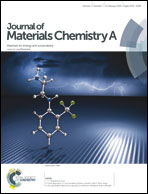A high-rate aqueous symmetric pseudocapacitor based on highly graphitized onion-like carbon/birnessite-type manganese oxide nanohybrids†
Abstract
We present a study on the pseudocapacitive properties of birnessite-type MnO2 grafted on highly graphitized onion-like carbon (OLC/MnO2). In a three-electrode setup, we evaluated two different substrates, namely a platinum disc and nickel foam. The OLC/MnO2 nanohybrid exhibited a large specific capacitance (Csp) of 295 and 323 F g−1 (at 1 A g−1) for the Pt disc and Ni foam, respectively. In addition, the Ni foam substrate exhibited much higher rate capability (power density) than the Pt disc. A symmetrical two-electrode device, fabricated with the Ni foam, showed a large Csp of 254 F g−1, a specific energy density of 5.6 W h kg−1, and a high power density of 74.8 kW kg−1. These values have been the highest for onion-based electrodes so far. The device showed excellent capacity retention when subjected to voltage-holding (floating) experiments for 50 h. In addition, the device showed a very short time constant (τ = 40 ms). This high rate handling ability of the OLC/MnO2 nanohybrid, compared to literature reports, promises new opportunities for the development of aqueous-based pseudocapacitors.


 Please wait while we load your content...
Please wait while we load your content...